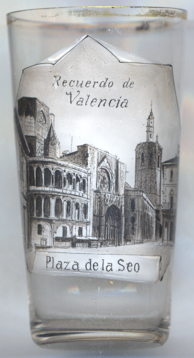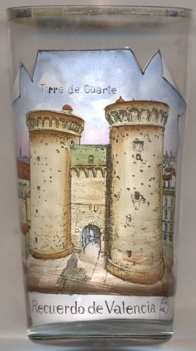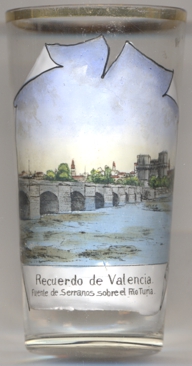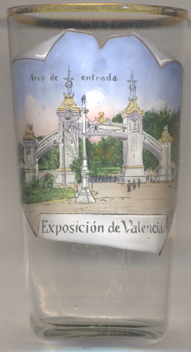

|
| ESPAÑA | Spain |
| Communitat Valenciana / Comunidad Valenciana | Valencia |
| província: València / provincia: Valencia |
València (Valencia) is situated at Spanish Mediterranean coast, about 350 km south of Barcelona and 320 km southeast of Madrid at the mouth of the river Turia. It is the capital of the Autonomous Valencian Community. At a populaton of about 788,000 (2017) it is the third-largest city in Spain.
Valentia Edetanorum was founded as a Roman colony in 138 BC. In 714 Moroccan and Arab Moors occupied the city, introducing their language, religion and customs; they implemented improved irrigation systems and the cultivation of new crops as well. Valencia was the capital of the Taifa of Valencia. In 1238 the Christian king Jaime I of Aragon conquered the city. He also created a new law for the city, the Furs of Valencia, which were extended to the rest of the Kingdom of Valencia. In the 18th century Philip V of Spain abolished the privileges as punishment to the kingdom of Valencia for aligning with the Habsburg side in the War of the Spanish Succession. Valencia was the capital of Spain when Joseph Bonaparte moved the Court there in the summer of 1812. It also served as capital between 1936 and 1937, during the Second Spanish Republic.

The  Església Catedral-Basílica Metropolitana de l'Assumpció de la Mare de Déu de València
(Castilian Spanish: Iglesia Catedral-Basílica Metropolitana de la Asunción de Nuestra Señora de Valencia)
was consecrated in 1238 by the first bishop of Valencia after the Reconquista and was dedicated to Saint Mary. It was built over the site of the former
Visigothic cathedral, which under the Moors had been turned into a mosque. Valencian Gothic is the predominant architectural style of the cathedral, although
it also contains Romanesque, French Gothic, Renaissance, Baroque and Neoclassical elements. A purported Holy Chalice, believed by many to be the true Holy
Grail, is kept in one of the cathedral's chapels.
Església Catedral-Basílica Metropolitana de l'Assumpció de la Mare de Déu de València
(Castilian Spanish: Iglesia Catedral-Basílica Metropolitana de la Asunción de Nuestra Señora de Valencia)
was consecrated in 1238 by the first bishop of Valencia after the Reconquista and was dedicated to Saint Mary. It was built over the site of the former
Visigothic cathedral, which under the Moors had been turned into a mosque. Valencian Gothic is the predominant architectural style of the cathedral, although
it also contains Romanesque, French Gothic, Renaissance, Baroque and Neoclassical elements. A purported Holy Chalice, believed by many to be the true Holy
Grail, is kept in one of the cathedral's chapels.
The parts of the cathedral depicted on glass no. 4592 [left] are (from left to right):
The Obra Nova ('New Work'), a three-storey ribune with open arcades in Renaissane (lower floor), Tuscan (middle floor) and Ionic (upper floor) styles,
was constructed from 1566 onwards. In one of the restorations of the cathedral during the second half of the 20th century, its roof was removed and
the balconies and columns became more prominent.
The Puerta de los Apóstolos (Apostles' Gate) was constructed in 1303–1354 and is located on the western end of the transept,
presumably at the location of the entrance of the ancient mosque. The door jambs or leaves, the nails and the door hardware are original from 1438.
During the 1960s the door was completely restored and the original figures - in a very poor state of conservation - were exhibited in the cathedral
museum and replaced by copies, which are the ones that decorate the door today.
The Micalet or Miguelete (Miguelete Tower) was built between 1381 and 1429 in Valencian style Gothic. It is 51 metres high to the terrace,
and 63 metres in total. It has the shape of an octagonal prism and has 207 steps. Originally it was a separate tower, and it was joined to the Cathedral
at the end of the 15th century when the central nave was extended. The bell room was modified during a renovation in the 1980s, which included the
electrification of the bells.

The  Torres de Quart, also called Torres de Cuarte, [near left, no. 4213]
are one of the two fortified gates of the medieval wall of Valencia that are still standing. The complex is made up of two semi-cylindrical towers
joined by a central body, where the door itself opens, in the shape of a semicircular arch. The Towers owe their name to the fact that they were located
on the road that led from the city center, from the Plaza de La Virgen, where the Cathedral of Valencia is located, to the town of Cuart de Poblet. The
towers were the western access for traffic coming from Castile. The Quart Towers were built between 1441 and 1460. In 1931 they were declared a National
Monument.
Torres de Quart, also called Torres de Cuarte, [near left, no. 4213]
are one of the two fortified gates of the medieval wall of Valencia that are still standing. The complex is made up of two semi-cylindrical towers
joined by a central body, where the door itself opens, in the shape of a semicircular arch. The Towers owe their name to the fact that they were located
on the road that led from the city center, from the Plaza de La Virgen, where the Cathedral of Valencia is located, to the town of Cuart de Poblet. The
towers were the western access for traffic coming from Castile. The Quart Towers were built between 1441 and 1460. In 1931 they were declared a National
Monument.

The  Puente de Serranos [near left, no. 4344], built in 1518, is the oldest still existing bridge
across the river Turia. It joins the main northern gate of the city with the road to the Maestrazgo (in Valencian: Maestrat) region and the city of
Sagunto, at the time the main route to the Los Serranos region, hence its name. Already in Muslim times it was known as A-Quantara, i.e. 'the bridge',
a denomination usually attribuated to stable bridges, usually made of stone and mostly of Roman origin. In 1349 a new stome bridge was ordered to be built
to better resist the floods of the river. The floods of 1406 and 1427, but especially that of 1517, inflicted serious damage on the bridge, so that a year
later, the bridge was rebuilt as we see it today. The bridge, with nine arches, is 159.7 metres long and 11.2 metres wide. Between 2005 and 2009 it was
restored.
Puente de Serranos [near left, no. 4344], built in 1518, is the oldest still existing bridge
across the river Turia. It joins the main northern gate of the city with the road to the Maestrazgo (in Valencian: Maestrat) region and the city of
Sagunto, at the time the main route to the Los Serranos region, hence its name. Already in Muslim times it was known as A-Quantara, i.e. 'the bridge',
a denomination usually attribuated to stable bridges, usually made of stone and mostly of Roman origin. In 1349 a new stome bridge was ordered to be built
to better resist the floods of the river. The floods of 1406 and 1427, but especially that of 1517, inflicted serious damage on the bridge, so that a year
later, the bridge was rebuilt as we see it today. The bridge, with nine arches, is 159.7 metres long and 11.2 metres wide. Between 2005 and 2009 it was
restored.

The Exposición Regional Valenciana of 1909 was a commercial and industrial exhibition
organized by the Mercantile Athenaeum of Valencia. It took place in Valencia from 22 May until 31 July 1909.
The whole of the exhibition occupied an area of 16 ha, in the form of a fairground through pavilions and buildings
located around the current urban framework of the Alameda de Valencia. The opening ceremony took place on 23 May in
the presence of King Alfonso XIII.
The  entrance to the fairgrounds [left, no. 3521] was designed by
D. Eustaquio Romero from San Sebastián.
entrance to the fairgrounds [left, no. 3521] was designed by
D. Eustaquio Romero from San Sebastián.
[https://de.wikipedia.org/wiki/Valencia, https://en.wikipedia.org/wiki/Valencia;
https://en.wikipedia.org/wiki/Valencia_Cathedral, https://es.wikipedia.org/wiki/Catedral_de_Santa_Mar%C3%ADa_(Valencia)#Obra_Nova;
https://en.wikipedia.org/wiki/Miguelete_Tower;
https://es.wikipedia.org/wiki/Torres_de_Quart;
https://es.wikipedia.org/wiki/Exposición_Regional_Valenciana_de_1909]
![[scale]](lineal.jpg)